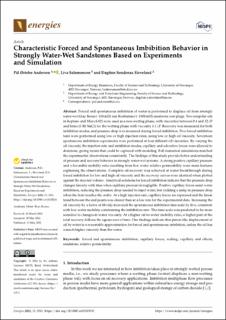| dc.contributor.author | Andersen, Pål Østebø | |
| dc.contributor.author | Salomonsen, Liva | |
| dc.contributor.author | Sleveland, Dagfinn Søndenaa | |
| dc.date.accessioned | 2022-05-13T11:31:27Z | |
| dc.date.available | 2022-05-13T11:31:27Z | |
| dc.date.created | 2022-05-10T08:59:52Z | |
| dc.date.issued | 2022-05 | |
| dc.identifier.citation | Andersen, P. Ø., Salomonsen, L., & Sleveland, D. S. (2022). Characteristic Forced and Spontaneous Imbibition Behavior in Strongly Water-Wet Sandstones Based on Experiments and Simulation. Energies, 15(10), 3531. | en_US |
| dc.identifier.issn | 1996-1073 | |
| dc.identifier.uri | https://hdl.handle.net/11250/2995627 | |
| dc.description.abstract | Forced and spontaneous imbibition of water is performed to displace oil from strongly water-wet Gray Berea (~130 mD) and Bentheimer (~1900 mD) sandstone core plugs. Two nonpolar oils (n-heptane and Marcol-82) were used as a non-wetting phase, with viscosities between 0.4 and 32 cP and brine (1 M NaCl) for the wetting phase with viscosity 1.1 cP. Recovery was measured for both imbibition modes, and pressure drop was measured during forced imbibition. Five forced imbibition tests were performed using low or high injection rates, using low or high oil viscosity. Seventeen spontaneous imbibition experiments were performed at four different oil viscosities. By varying the oil viscosity, the injection rate and imbibition modes, capillary and advective forces were allowed to dominate, giving trends that could be captured with modeling. Full numerical simulations matched the experimental observations consistently. The findings of this study provide better understanding of pressure and recovery behavior in strongly water-wet systems. A strong positive capillary pressure and a favorable mobility ratio resulting from low water relative permeability were main features explaining the observations. Complete oil recovery was achieved at water breakthrough during forced imbibition for low and high oil viscosity and the recovery curves were identical when plotted against the injected volume. Analytical solutions for forced imbibition indicate that the pressure drop changes linearly with time when capillary pressure is negligible. Positive capillary forces assist water imbibition, reducing the pressure drop needed to inject water, but yielding a jump in pressure drop when the front reaches the outlet. At a high injection rate, capillary forces are repressed and the linear trend between the end points was clearer than at a low rate for the experimental data. Increasing the oil viscosity by a factor of 80 only increased the spontaneous imbibition time scale by five, consistent with low water mobility constraining the imbibition rate. The time scale was predicted to be more sensitive to changes in water viscosity. At a higher oil-to-water mobility ratio, a higher part of the total recovery follows the square root of time. Our findings indicate that piston-like displacement of oil by water is a reasonable approximation for forced and spontaneous imbibition, unless the oil has a much higher viscosity than the water. | en_US |
| dc.language.iso | eng | en_US |
| dc.publisher | MDPI | en_US |
| dc.rights | Navngivelse 4.0 Internasjonal | * |
| dc.rights.uri | http://creativecommons.org/licenses/by/4.0/deed.no | * |
| dc.subject | petroleumsteknologi | en_US |
| dc.title | Characteristic forced and spontaneous imbibition behavior in strongly water-wet sandstones based on experiments and simulation | en_US |
| dc.type | Peer reviewed | en_US |
| dc.type | Journal article | en_US |
| dc.description.version | publishedVersion | en_US |
| dc.rights.holder | Copyright © 2022 by the author(s) | en_US |
| dc.subject.nsi | VDP::Teknologi: 500::Berg‑ og petroleumsfag: 510 | en_US |
| dc.source.volume | 15 | en_US |
| dc.source.journal | Energies | en_US |
| dc.source.issue | 10 | en_US |
| dc.identifier.doi | 10.3390/en15103531 | |
| dc.identifier.cristin | 2022920 | |
| dc.relation.project | Norges forskningsråd: 331644 | en_US |
| dc.source.articlenumber | 3531 | en_US |
| cristin.ispublished | true | |
| cristin.fulltext | postprint | |
| cristin.qualitycode | 1 | |

